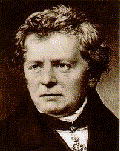Georg Simon Ohm's Law
The steel chassis of your vintage Gretsch 6160 conducts electrons very well. Place a small voltage between any two points and you'll get a lot of current between them. Likewise if you pump a lot of current between any two points then you won't get much voltage. It simply takes very little work to move charge between these points. Trying to pass current across any two points on the 6160's tweed cabinet is a completely different story. It takes a lot of work to push even a miniscule amount current through it. We conclude that the chassis is a conductor and the cabinet is, well, a non-conductor. Tweed has a high resistance to the flow of electric current.
The fundamental law governing the relationship between voltage, current, and resistance is Ohm's Law:
V = IR
This incredibly powerful, and yet amazingly simple principle was discovered by Georg Simon Ohm.

It therefore stands to reason that when the voltage is in volts and the current is in amps then the resistance R is in units called "ohms," denoted by the symbol Ω. Perhaps the most common phrase in the world of electronic circuit design is "according to Ohm's Law." It simply crops up again and again.

|
Guitar Amplifier Electronics: Fender Deluxe - from TV front to narrow panel to brownface to blackface Reverb |
Problem
You measure the DC resistance across a replacement choke for your Bassman 5F6-A clone and get 107 ohms. You note that when there is no guitar signal, one end of the choke is at 432 volts and the other is at 430.8 volts. The choke supplies current to 2 preamps, a cathode follower, and a phase inverter. How much total current do all of these stages consume?
Solution
From Ohm's Law we can compute any of the three quantities when we know the values of the other two. Using units of volts, amps, and ohms, we need to just pick the appropriate formula:
V = IR
I = V/R
R = V/I
In this case the voltage drop across the choke is 432V-430.8V = 1.2V, so the current is 1.2V/107Ω = 11mA.

|
Guitar Amplifier Electronics: Basic Theory - master the basics of preamp, power amp, and power supply design. |
Resistors
Most resistances in a tube amp are intentional - we actually insert a resistor with the appropriate value into the circuit. The two key features of a resistor are its value in ohms and the maximum amount of power it can handle in watts. Resistor values vary widely, so to eliminate zeros we use 1kΩ instead of 1000Ω and 1MΩ instead of 1000000Ω.
Problem
The DC plate supply voltage for the first preamp of the Fender Deluxe 6G3 is 270V and the plate of the 7025 tube is at 165V. The plate resistor has a resistance of 220kΩ. What is the current through the resistor? How much heat does it produce?
Solution
The voltage drop across the resistor is 270V - 165V = 105V. According to Ohm's Law the current is
105V / 220kΩ = 0.48mA
The power in the resistor, which is given off as heat, is the voltage multiplied by the current:
(105V)(0.48mA) = 50mW
Small resistors are usually rated at 250 milliwatts or 500 milliwatts maximum rated power. Either would be suitable for this application.

|
Fundamentals of Guitar Amplifier System Design - design your amp using a structured, professional methodology. |
Problem
At full power and maximum supply voltage sag, the Fender Bassman 5F6-A power supply sustains a load of 187mA at 377V. If we were to replace the Bassman's preamps, phase inverter, and push-pull power stage by a big resistor, what value would the resistor need to have to get the power supply to sag to 377V? How many watts of heat would the resistor produce?

|
From system design concepts to individual stage operation, an all-new examination of Bassman electronics. |



